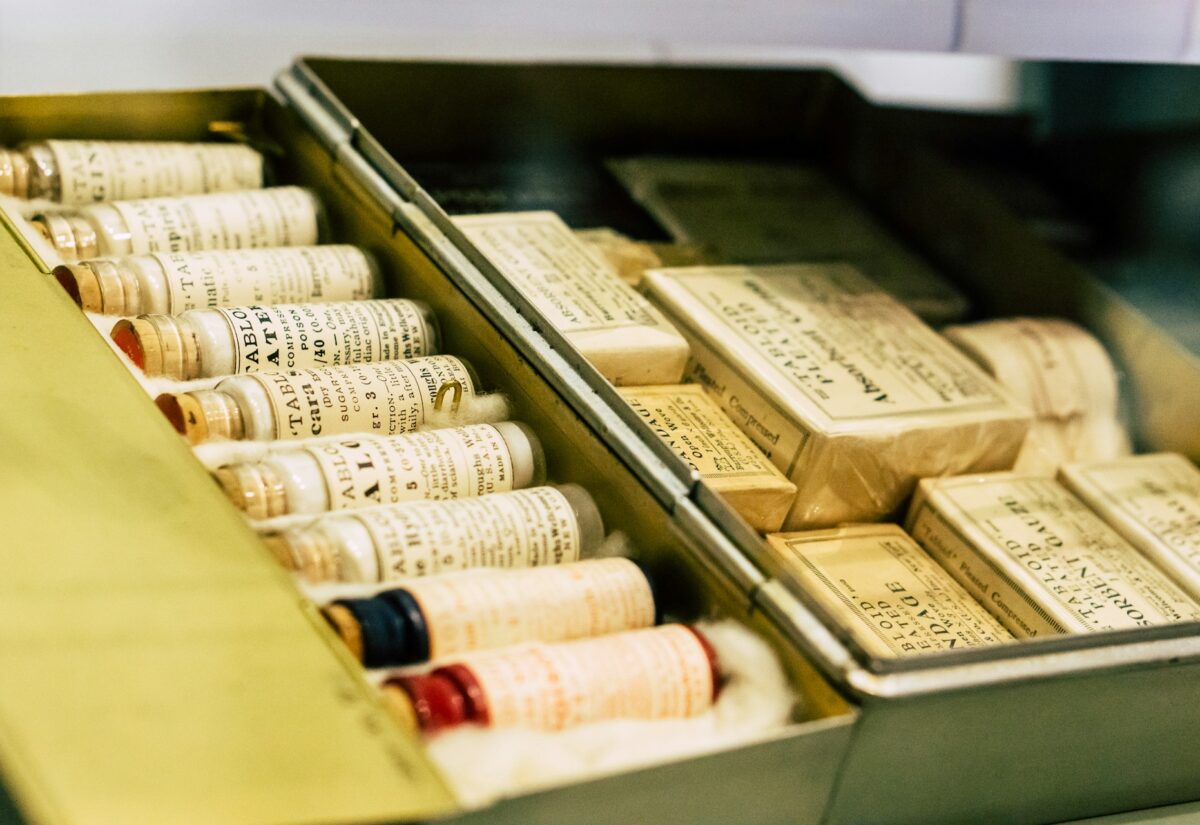Historical ‘Medicines’ That Definitely Made People Worse
- Jennifer Still
- May 10, 2025
 Unsplash/Tatiana Rodriguez
Unsplash/Tatiana RodriguezModern medicine has come a long way, but the road to understanding the human body has been bumpy, brutal, and often horrifying. Before clinical trials, peer-reviewed journals, or germ theory, people turned to whatever remedies they could find—be it herbs, heavy metals, animal parts, or methods based on deeply flawed assumptions about how the body worked. The line between medicine and poison was blurred at best, and many treatments that were widely accepted for centuries were not only ineffective, they were actively harmful. Here are some of the most alarming historical ‘medicines’ that definitely made people worse.
Mercury treatments
For centuries, mercury was prescribed as a catch-all remedy for everything from syphilis to constipation. Its use can be traced back to ancient China and Greece, but it became particularly prominent in Europe during the Renaissance. Mercury compounds were used in ointments, pills, enemas, and even vapour baths. Syphilis sufferers were instructed to coat their bodies in mercury paste or inhale the vapour in special rooms.
Instead of healing patients, mercury slowly poisoned them. The symptoms of mercury poisoning—excessive salivation, tooth loss, tremors, kidney damage, and insanity—were often mistaken for signs that the treatment was working. Some patients even died before the syphilis had a chance to run its course. Tragically, the treatment outlived its usefulness by centuries.
Bloodletting
Few historical treatments were as enduring—or damaging—as bloodletting. Based on the ancient Greek belief in the four humours, bloodletting was intended to rebalance the body’s internal systems by removing excess blood. It was used for everything from colds and headaches to pneumonia, plague, and smallpox.
Doctors used knives, lancets, and later, leeches, to drain pints of blood from patients who were often already weak or dehydrated. The more severe the illness, the more blood was taken. George Washington was bled heavily during his final illness, likely accelerating his death. Despite mounting criticism, the practice persisted into the 19th century, harming untold numbers of patients.
Trepanation
Trepanation—cutting or drilling a hole into the skull—has been practised for thousands of years and was once thought to release evil spirits, relieve pressure, or cure conditions like epilepsy and migraines. Archaeological evidence shows that ancient cultures across Europe, Africa, and South America all used this method.
Although some patients miraculously survived, often with bone regrowth evident in their skulls, many others would have died from infection, blood loss, or brain trauma. The procedure resurfaced in the Middle Ages and Renaissance, often combined with bloodletting. Today, trepanation is still performed—illegally—by fringe groups convinced it enhances consciousness.
Arsenic tonics
During the 18th and 19th centuries, arsenic wasn’t just found in rat poison—it was in health tonics, cosmetics, and even everyday pills. Advertised as a way to brighten the skin, improve stamina, and treat everything from malaria to menstrual problems, arsenic pills were easy to buy and widely used.
Over time, arsenic builds up in the body, causing a slow decline marked by vomiting, confusion, skin damage, and organ failure. In some cases, habitual users were slowly poisoning themselves to death under the mistaken belief that they were getting healthier. It’s a bleak reminder of how beauty and health trends can sometimes be deadly.
Tobacco as a remedy
When tobacco arrived in Europe in the 16th century, it was quickly hailed as a miracle plant. Doctors claimed it could treat everything from colds and toothaches to constipation and the plague. Tobacco smoke was used as an enema—blown into the rectum with bellows to resuscitate drowning victims. Pipes were prescribed to calm nerves or ward off illness.
Needless to say, these practices did more harm than good. Smoking irritates the lungs and increases the risk of cancer, heart disease, and stroke. Blowing smoke into someone’s body cavity as a medical intervention is now seen as not just dangerous, but absurd. But at the time, it was cutting-edge medicine.
Mummy powder
The European obsession with Egyptian mummies led to one of the strangest medical fads in history. From the 12th to the 17th century, powdered mummy—ground-up remains of embalmed corpses—was believed to have healing properties. Apothecaries sold it as a treatment for internal bleeding, bruising, and epilepsy.
Eventually, demand outstripped supply, leading to the use of recently deceased bodies instead. The medical use of mummy powder was macabre, unethical, and potentially dangerous. It exposed patients to harmful bacteria and likely did nothing to improve their health. Worse, it encouraged the plundering and desecration of ancient graves.
Radium water
After Marie and Pierre Curie discovered radium, its glow was seen as a symbol of health and vitality. Entrepreneurs seized the opportunity to bottle it—literally. Products like Radithor, a radium-infused water, promised to cure everything from arthritis to impotence. It was marketed to the rich and even sold through doctors.
One infamous case was that of Eben Byers, a wealthy American who drank Radithor daily until his bones began to rot and his jaw fell apart. He died in 1932, riddled with radiation damage. His death prompted the US government to crack down on radioactive quackery, but not before thousands were exposed to harmful doses.
Lobotomies
The lobotomy was introduced in the 1930s as a revolutionary treatment for mental illness. Surgeons used metal tools to sever connections in the frontal lobe, often entering through the eye socket with an ice-pick-like instrument. The goal was to calm patients with schizophrenia, depression, or anxiety.
While a few patients showed initial improvement, most were left with severe cognitive and emotional impairments. Some lost the ability to speak or care for themselves. In the US alone, tens of thousands underwent lobotomies before the practice fell out of favour. It’s now viewed as one of the darkest chapters in psychiatric history.
Heroic medicine
In the 18th and early 19th centuries, “heroic medicine” was the dominant medical philosophy. Doctors believed the more aggressive the treatment, the better the outcome. This approach favoured intense purging, violent vomiting, bloodletting, blistering, and the use of toxic substances like mercury chloride (calomel).
Patients endured extreme discomfort, often left physically destroyed by the very people meant to heal them. These treatments were used not only for life-threatening illnesses but also for mild ailments. Heroic medicine eventually fell out of favour as scientific approaches gained ground, but its legacy is a sobering example of misplaced confidence.
Animal-based remedies
Throughout history, animals were not just part of diets—they were used as medicine. Dead toads were worn around the neck or placed in shoes to cure arthritis. Mouse paste was applied to warts. Animal dung, urine, and bile were turned into ointments or potions. Insects like crushed beetles and powdered millipedes made their way into early pharmacology.
Very few of these remedies had any medicinal value, and many introduced bacteria or toxins. These practices were often rooted in folk traditions, sympathetic magic, or symbolic associations—such as using a fast creature to treat lethargy. The results were usually more harmful than helpful.
Lead-based treatments
Like mercury and arsenic, lead was once considered a useful ingredient in medicine. It was used to treat skin conditions, diarrhoea, and inflammation. In Roman times, lead was added to wine for flavour and used in pipes, pots, and cosmetics.
Exposure to lead causes a host of problems, including neurological damage, infertility, and death. Children were particularly vulnerable. Its effects were slow and cumulative, so it often took years to link lead exposure to symptoms. The damage done by lead poisoning likely shaped generations, both physically and intellectually.
Snake oil and travelling cures
By the 19th century, travelling medicine shows and snake oil salesmen became widespread, particularly in the United States and parts of Europe. These vendors sold tonics and elixirs with grand claims: cure-all remedies for everything from baldness to cancer.
Most of these products contained alcohol, opium, cocaine, or nothing at all. They often did more damage than the illness they claimed to treat, leaving people addicted, poisoned, or broke. Despite their reputation, these fraudulent remedies were incredibly popular—and paved the way for modern consumer scepticism about health marketing.



